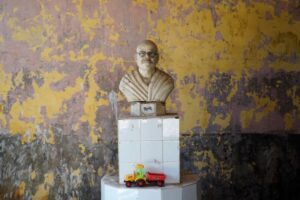Anuj Ambalal presents a visual narrative of Gandhi’s Salt March at IIC

Dhulaji Vaghri who milked a goat for Gandhi at Anakhi and Lakshmansinh Chavda walked with the marchers from Sabarmati Ashram till Income Tax Circle, Ahmedabad
Rajkumari Sharma Tankha
An interesting photo exhibition is presently on at India International Centre (IIC), New Delhi. Titled 23 Grams of Salt, the exhibition showcases photographs of the places Gandhi passed through during the Salt March also called as Dandi March in 1930 while he protested against the salt tax levied by the British demanding its abolition.
Photographer Anuj Ambalal covered the 385 km distance that Gandhi covered from Sabarmati Ashram to Dandi, a village in Navsari district, Gujarat, clicking pictures all the way, especially of those places where Gandhi stayed. He took almost two years to complete the task during which he visited over eighty villages through which the march had passed.
Ambalal has tried to build a visual narrative of the Salt March by depicting the villages, people, environment, landscapes, trees and buildings, as they exist today. “But some sites like Saifee Villa in Dandi are fairly well-preserved, many have changed; some sites are razed to ground,” he informs.
Included in the display are copies of personal letters that Gandhi wrote during the March; and short video film interviews of some of the surviving witnesses of the Salt March.
Razor & sharpening stone which barber Narottam
Valand used to shave Gandhi at Rayma
The beginning
It all started when I got hold of the book On the Salt March by Thomas Weber in 2012 Weber had visited these places in early 1980s. “It made me very curious on how these places where marchers rested would look like today. I started thinking about those buildings, villages and people: would they still be around after all these years? If so, in what state might they be? This benign curiosity soon turned into an obsession and led me to undertake my own journey in search of the Salt March sites,” says Ambalal.
Ginning mill in Derol where the marchers spent a night
But, of all the historical events why Salt March?
Salt March is of great significance but we all know it only as a political campaign but that is only half the story. There was a social aspect as well to it. Gandhi was also trying to cause social awakening through this march – through his actions, speeches and writings while on the march. The social aspect is not readily available in books. I came to know when I started researching about Salt March. More importantly, whatever things Gandhi spoke about in 1930 are still relevant today.
Spot in Karadi where Gandhi wrote his famous letter to Viceroy
There is another reason: Despite it being a major event in the history of Indian Independence, there is no visual history of it. None of the books carry any visual reference of the places Gandhi went through during the Salt March, which is very surprising. Of course, there are a few clips of Gandhi being on March but the pictures of villages and sites are not in public domain. That’s what made me very interested to photograph these places.
Hriday Kunj gate, Sabarmati Ashram, Ahmedabad
23 grams?
Because that’s the amount of salt that was extracted from the fistful of mud Gandhi picked up from Dandi beach upon arrival. The Brits had removed truckloads of salt from the beach a night before in a bid to foil Gandhi’s march, without realizing that it was only a symbolic march.
Gandhi Temple in Gajera
Any Challenges…
Plenty. Lack of adequate information required to locate and identify the historic locations in the present day was a big concern. I had to rely on descriptions given in books and oral narratives of the locals. 90 years is a long, long time. The sites have changed a lot over the years. Many original buildings have been demolished. Original inhabitants have migrated which means there are hardly a few to tell you the old tales.
Room in Dandi where Gandhi spent the last night of the march
On my travels, mostly I met second-generation locals in their 70s & 80s, who narrated me stories of the march that they had heard from their elders. This information has not been passed on to the next generation and is likely to be lost in the coming years. Having travelled the entire route and seen the decline of the structures first hand, I am certain that not many of the dilapidated buildings will survive the next decade if something is not done about them urgently.
Room in Boriavi where Gandhi rested
Personal tidbits
Significantly, Ambalal has had no formal training in photography. He professionally qualified in Finance from Middlesex University, London and was working as an Equity Researcher when he realized that “this is not what I can do the whole of my life”.
Other than photography, Ambalal runs a design studio in Ahmedabad – the city where he lives, and loves dabbling in various other forms of art like music.
The exhibition is on at Art Gallery, Kamaladevi Complex till May 24, 11:00 to 19:00










